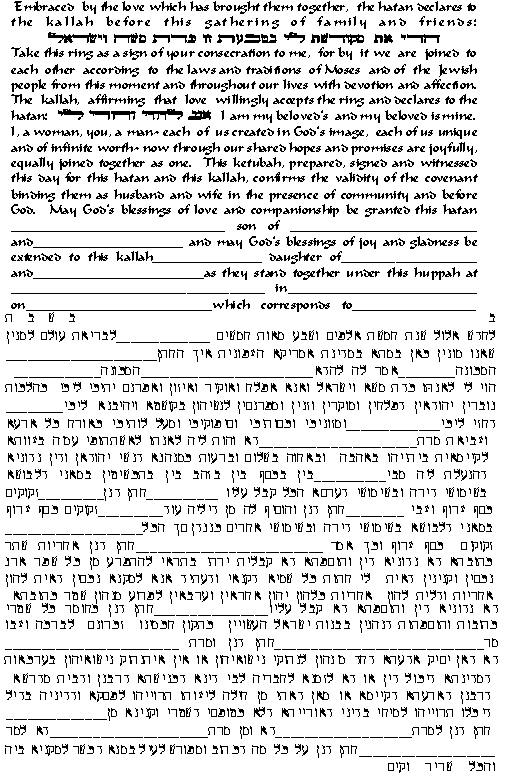|



|
The
Ketubah: Standard Text
A Conservative
Perspective by Rivka
C. Berman
• Egalitarian Ketubot
• Additional Clauses
• The Lieberman Clause
• Tnai b'Kiddushin: Contingence of
Marriage
• Sample of Conservative Ketubah Text
The Traditional Aramaic ketubah text is the only text accepted by the
Traditional Orthodox Ashkenazic Jewish community. The text was conceived
approximately 2,000 years ago, with the primary purpose of protecting the
finances of a Jewish wife.
The ketubah stipulates wife’s right to support, clothing and sexual satisfaction. A husband’s obligation to pay for his wife’s medical and burial costs were included as well. A general statement in the
ketubah. The ketubah further assured a woman would leave a marriage with the dowry she brought to it, and the interest it earned.
A ketubah handed from a husband to the wife is symbolic of the covenant Moses wrote as the Jewish people accepted God at Mount Sinai.
Traditional ketubah texts fell into disfavor as the modern age dawned
because the ketubah set men as masters of the marriage. More egalitarian
texts have been written, where the couple pledges support to each other.
References to the woman being a betulah, which translates as “virgin”
have been excised. The original text made no mention of a man’s virginity. (In
the context of the ketubah, the term betulah referred to a woman
who had never been married before and not necessarily her sexual history.)
Instead the term penuya, unmarried, appears in reference to the bride and
panui, the male form of the word is written before the groom’s name.
Brief mention of financial pledges continue to be included in the traditional
Conservative text.
Egalitarian Ketubot
Traditional texts enumerate a man’s obligations to his wife. Couples pledge to
uphold these bonds of love, honor and support to each other in egalitarian
versions. In addition, both the bride and groom envelop their beloved with the
holiness of marriage with the words “You are consecrated unto me according to
the traditions of Moses and Israel.”
Idealistic words of love follow. “We also pledge to establish a home open to the
spiritual potential in all life.” Another version continues “We pledge to be
sensitive at all times to each other’s needs, to attain mutual intellectual,
emotional, physical and spiritual fulfillment.”
Some couple put their hearts on paper and write their own ketubah or add
loving addenda to the standard text. Common law marriage is recognized in
Judaism, so what a couple includes or leaves out of a ketubah will not
change the validity of their marriage.
Additional Clauses
Some husbands have been known to take advantage of the halacha that
places the power of divorce in their hands. They spitefully withhold a Jewish
divorce from their wives. Since a Jewish woman cannot remarry without a Jewish
divorce, these women become agunot (chained women).
The Lieberman Clause
In 1954, Rabbi Saul Lieberman, a professor at the Jewish Theological Seminary (JTS),
studied the issue and wrote what has come to be known as the Lieberman Clause.
Written as part of the Ketubah, the Lieberman Clause states if a get is
not given, then the couple will appear before the Bet Din of the JTS and the
Rabbinical Assembly and obey their directives so both can go on to live full
Jewish lives. This means a potentially problematic husband agrees in advance to
abide by the decision of the Bet Din.
Written in Aramaic, the Lieberman Clause frequently does not appear in the
translation of the ketubah. Perhaps this is because the English translation
emphasizes the loving parts of the ketubah.
T'nai b'Kiddushin
To overcome some of the legal ambiguities left open by the
Lieberman Clause, another prenuptial document, the T’nai B’Kiddushin, a
condition of marriage, was introduced. This is a separate document from the
ketubah. It is signed by the groom and says: “If we should be divorced
civilly, and within a period of six months after the civil divorce I give you a
get, then the kiddushin are valid. But if we should be divorced civilly,
and within a period of six months after the civil divorce I do not grant you a
get, then the marriage was not a valid one.”
Sample of
Conservative Ketubah Text
inclusive of the Lieberman Clause



|
|







